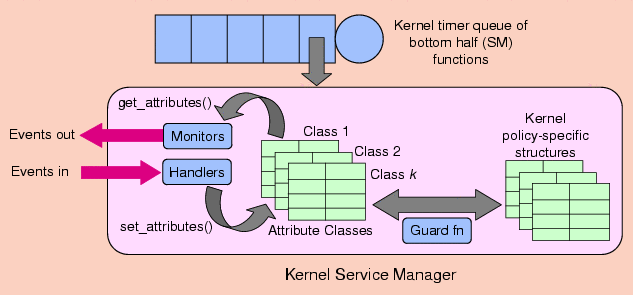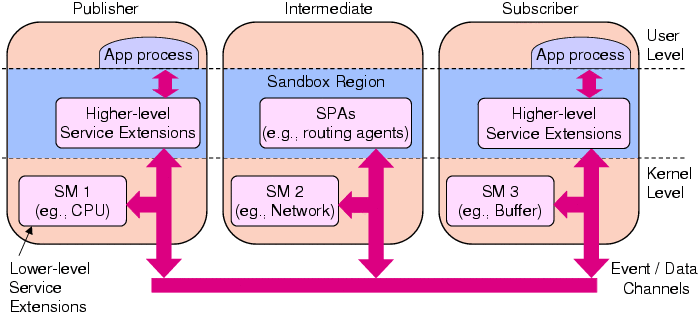The ubiquity and acceptance of the Internet in our
society has encouraged the development of many applications that are
inherently
real-time in nature. Examples include multi-source streaming
media
delivery, interactive distance learning, webcasting, group simulations,
live
auctions, and stock brokerage applications. These applications require
quality
of service(QoS) guarantees on the data exchanged between processes on
different
hosts. The QoS requirements on this data are typically in terms of
throughput,
loss, delay and jitter. Moreover, the resource demands to meet these
QoS
requirements may vary at run-time. For example, a target tracking
application
may require more or less CPU cycles to identify an object of interest
in
a graphical image, depending on the content of that image.
Existing general-purpose operating systems are ill-equipped to meet the
QoS requirements of applications like those described above.
Consequently, many classes of real-time applications have been
developed to compensate for inadequate system support, or to run on
special-purpose systems. Alternatively, many researchers have provided
middleware solutions that bridge the `semantic gap' between the needs
of applications and the services provided by the
system. Unfortunately, middleware solutions lack fine-grained control
over
system resources, thereby limiting the rate at which resource
allocations
can be adapted. For example, many of the CORBA-based (middleware)
adaptation
frameworks now being developed are subject to the costs of monitoring
and
adapting system resource usage via processes and system calls, that
have
limited capabilities.
It is desirable to implement QoS management abstractions at the
kernel-level, as opposed to using middleware, so that resources are
managed more efficiently and better service is provided to real-time
applications. Moreover, if
these abstractions are implemented in general-purpose systems, improved
service is possible for many desktop applications with QoS constraints
(e.g., RealNetworks RealPlayer, or Windows Media Player). It is
therefore
beneficial to extend the behavior of existing commodity `off-the-shelf'
operating systems, by incorporating new service abstractions and
interfaces.
Unfortunately, most commodity systems are structured around monolithic
kernels
that have not been designed to support extensibility or specialization
of system behavior. Although some
systems support limited extensibility, by allowing device drivers to be
loaded
at run-time (e.g., Linux and Solaris), they lack support for code
extensions that override or alter the behavior of system-wide service
policies.
Figure1: The Dionisys
infrastructure spanning three hosts. It supports kernel- and user-level
(sandboxed) extensions.
As a consequence, we are developing a combined kernel- and user-level
adaptive QoS
management infrastructure, called Linux Dionisys (see Figure 1). In
this infrastructure,
application
processes link with a Dionisys library to create service extensions.
Service
extensions can be passed around the system to
SafeX
daemon processes, where they are compiled and linked into the address
space of the target kernel or user-level sandboxes. In the original
Dionisys prototype, these service extensions were either
monitors
,
handlers or
service managers. We are
now developing support for high-level
sandboxed
service extensions for application data management, such as
stream processing agents
(SPAs).
A service
manager is an encapsulation of a resource management subsystem, and has
a corresponding policy for providing service of a
specific type. For example, a CPU service manager may have (potentially
configurable) policies for CPU scheduling and synchronization, while a
network service manager might have policies for flow control and/or
packet scheduling. Low-level service managers (e.g., for CPU, network
or memory management) are typically linked into the kernel
address space, whereas high-level (e.g., for application data
management) are typically linked into the address space of user-level
sandboxes. Sandboxed service extensions may include stream processing
agents, for relaying/routing, filtering, transforming, splitting or
merging application data streams, exchanged between hosts. In
effect, it is possible to deploy sandboxed agents on strategic
intermediate hosts for the purpose of end-system multicasting and
QoS-constrained routing (in a manner similar to Narada or Pastry). One
of the main targets of this work, therefore, is to provide scalable
end-system solutions to the real-time transport and delivery of data
streams from publishers to potentially thousands of subscribers (with
independent QoS constraints).
Kernel Service Managers
Observe that
kernel service
managers (see Figure 2) run as bottom half handler routines
that are invoked periodically or in response to events within the
system. This enables extensions to execute asynchronously to
application processes, so an application may influence the way
resources are allocated to it even when not scheduled.
 Figure 2: A kernel service manager
implemented as a bottom half handler
Figure 2: A kernel service manager
implemented as a bottom half handler
Each service manager has two queues for monitor and handler functions.
A monitor function,
M, bound to the queue of service
manager,
S, is executed periodically on behalf of an
application,
A. Using the interfaces provided by the SafeX daemons,
M observes the service provided to
A by
S. Similarly, a handler function,
H, that is
bound
to the queue of
S and operating on behalf of an
application,
A' , is executed in response to events from a
corresponding
monitor function associated with
A'.
H
uses SafeX interfaces to influence changes to the service provided by
S, so that improved service (or guaranteed QoS) is provided to
A'. Moreover, applications can create
event channels
(using the
MEDEA subsystem) between their
monitor and handler functions, so that deficiencies in one monitored
service can trigger compensatory changes in the same or other service
managers.
Monitors and handlers operate on
attribute classes.
These are data structures that hold the names of various QoS attributes
and their corresponding values. For example, a name-value pair
referring to CPU scheduling priority would be
(priority-numeric_value).
As another example, an application-specific attribute for a video
application might be
(frame_rate-numeric_value) . These
attribute classes are created by applications and linked into the
kernel address space of a given host by a SafeX daemon.
Service extensions and applications get and set these attributes by
name,
as long as they have the necessary access rights.
Each host has a separate attribute store for each application, that is
identified by a
class descriptor. Application processes
and service extensions on a given host may only retrieve and set
attributes
in the corresponding attribute class on the local host (as identified
by
a class descriptor). As with service extensions, an application process
can create an attribute class for deployment on a remote host. Access
to this class is granted to remote processes that acquire permission
from the class creator. Observe that the nameserver in the figure
shown above maintains a database of bindings of class descriptors
to attribute classes on each
host, event channel ids to actual channels, and service extension names
to their actual locations.
Each service manager is equipped with a
guard function
that is automatically generated by the code generator in a SafeX daemon
process running on the same host. A guard function is responsible for
the
mapping of attributes, contained in attribute classes, to kernel
policy-specific structures. It ensures that attributes are within valid
ranges and will
not affect the QoS guarantees to the corresponding application, or
other
applications. Observe that each SafeX daemon process implements a code
generator
and linker/loader, for compiling and linking extension code into the
host's
kernel address space. Moreover, each SafeX daemon is capable of
generating
code for run-time safety checks of extensions, thereby guaranteeing
they
have bounded execution time.



